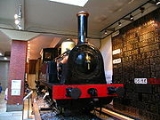
Japan Railways locomotive numbering and classification
Encyclopedia
This page explains the numbering and classification schemes for locomotive
s employed by the Japanese Government Railways
, the Japanese National Railways
and the Japan Railways Group.
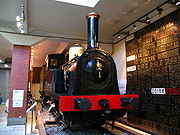 Prior to the nationalization of Japanese railways
Prior to the nationalization of Japanese railways
in 1906 and 1907, the government-run railways had numbered their steam locomotive
s only with serial numbers without consideration of the types of the locomotives. From the beginning of the Kobe–Osaka railway in 1874, they allocated odd numbers to locomotives in Tokyo area and even numbers to locomotives in Kobe area, but this was not maintained after the completion of railway between Tokyo and Kobe in 1889. Later, some locomotives, such as Classes A8 and B6 and rack railway
locomotives, were renumbered to make groups for easy recognition of classes.
Classes were introduced by Francis H. Trevithick (1850–1931), a grandson of Richard Trevithick
employed by the government of Japan for supervision of rolling stock management. He classified the locomotives with one Latin letter
(A through Z), which was then expanded to use two letters (AB, AC, AD, and so on).
Later, this simple method was revised to use one letter and one or two digit numerals with consideration of locomotive types. The meanings of the letters were as follows:
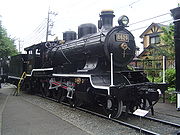 Following the railway nationalization, in 1909, the railway authority adopted a new system where locomotives were numbered and classified by four-digit numerals. All existing locomotives were reclassified. Numbers 1 through 4999 were allocated for tank locomotives and 5000 through 9999 were allocated for tender locomotives. Here the classes and the numbers acquired a distinct relationship. Locomotives were grouped in numbers and the classes were represented by the earliest number of the group.
Following the railway nationalization, in 1909, the railway authority adopted a new system where locomotives were numbered and classified by four-digit numerals. All existing locomotives were reclassified. Numbers 1 through 4999 were allocated for tank locomotives and 5000 through 9999 were allocated for tender locomotives. Here the classes and the numbers acquired a distinct relationship. Locomotives were grouped in numbers and the classes were represented by the earliest number of the group.
Numbers within a class were serial in principle. When the number overflowed (as in Classes 8620, 9600 and 9900), one digit was added to precede the four digits to make the numbers five digit. Class 18900 (later reclassified as Class C51) was exceptionally five digit from the beginning.
This numbering and classification rule survived the revision in 1928. Non-standard locomotives that joined the national railways by means of purchase of railway companies were numbered in accordance with this rule even after 1928. Locomotives numbered and classified under this rule includes the locomotives used until very last days of JNR steam locomotives in 1970s.
 Because the 1909 method were going to overflow, a new rule of numbering and classification came into effect on October 1, 1928. Except for Classes 18900, 8200 and 9900 being reclassified as C51, C52 and D50 respectively, existing locomotives were not reclassified or renumbered. After this revision, steam locomotives are classified and numbered with a Latin letter and numerals.
Because the 1909 method were going to overflow, a new rule of numbering and classification came into effect on October 1, 1928. Except for Classes 18900, 8200 and 9900 being reclassified as C51, C52 and D50 respectively, existing locomotives were not reclassified or renumbered. After this revision, steam locomotives are classified and numbered with a Latin letter and numerals.
Example: D51 200
Unlike electric and diesel locomotives, steam locomotives do not have an indication of the type of power source (steam) in their class names.
Number of driving axles
Class
According to this numbering method, D51 200 means locomotive number 200 of Class D51
, which is a class of tender locomotives with four driving axles.
s in 1912. Like steam locomotives at that period, electric locomotives were numbered with four or five digit numerals. Classes were represented by their earliest numbers, last digit being "0".
The table below lists all classes of the electric locomotives named under this method.
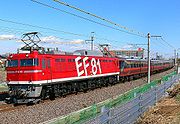 A new rule of numbering and classification came into effect in 1928. Originally, electric locomotives were classified by maximum speeds. High speed locomotives were for passenger trains and low speed locomotives were for freight trains. Later, the rule was revised to distinguish the types of electricity when AC
A new rule of numbering and classification came into effect in 1928. Originally, electric locomotives were classified by maximum speeds. High speed locomotives were for passenger trains and low speed locomotives were for freight trains. Later, the rule was revised to distinguish the types of electricity when AC
and AC/DC
locomotives were introduced.
Example: EF81 95
E
Number of driving axles
Class
Running number
According to this numbering method, EF81 95 means locomotive number 95 of Class EF81
, which is a class of AC/DC locomotive with six driving axles and maximum speed exceeding 85 km/h.
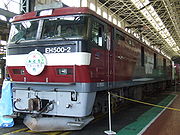 Out of seven Japan Railways Group (JR Group) companies established in 1987, only Japan Freight Railway Company
Out of seven Japan Railways Group (JR Group) companies established in 1987, only Japan Freight Railway Company
(JR Freight) has built new electric locomotives. Initially JR Freight continued to built locomotives originally designed by JNR with minor modifications. However, in 1990, it created the new class of EF200
, adopting the new classification rule with three-digit class names.
This rule is expected to be adopted by East Japan Railway Company
(JR East) as it will introduce Class EF510
by 2010.
Example: EH500-10
Usage of Roman letters is the same as the 1928 rule. A hyphen is placed between the class number and running number.
Class
According to this numbering method, EH500-10 means locomotive number 10 of Class EH500
, which is a class of AC/DC locomotive with eight driving axles and AC motors.
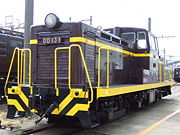 The history of diesel locomotive
The history of diesel locomotive
s of the Japanese Government Railways started with two classes of German-made locomotives, the diesel-electric Class DC11 in 1929 and the diesel-mechanical DC10 in 1930. The Ministry of Railways numbered them in accordance with the similar rule as it then used for steam and electric locomotives. The Japanese National Railways assumed this rule.
Example : DD13 1
D
Number of driving axles
Class
Running number
According to this numbering method, DD13 1 means locomotive number 1 of Class DD13, which is a class of diesel locomotive with four driving axles and maximum speed 85 km/h or less.
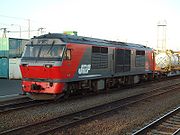 After the privatization of JNR in 1987, two Japan Railways Group (JR Group) companies created new classes of diesel locomotives. East Japan Railway Company
After the privatization of JNR in 1987, two Japan Railways Group (JR Group) companies created new classes of diesel locomotives. East Japan Railway Company
(JR East) classified its new class as DD19 with the JNR rule as it was only a rebuild of DD17, which was built by JNR. On the other hand, Japan Freight Railway Company (JR Freight) built completely new diesel locomotives, which were classified under the new rule with three-digit class names.
Example : DF200-12
Usage of Roman letters is the same as for JNR usage. A hyphen is placed between the class number and running number.
Class
According to this numbering method, DF200-12 means locomotive number 12 of Class DF200, which is a class of diesel-electric locomotive with six driving axles and AC electric motors.
system (for track maintenance and depot use) are diesel locomotives that are numbered with three-digit class names followed by a serial number connected with a hyphen. There have been two classes: 911 and 912.
In the uniform classification rule of Shinkansen rolling stock, the first digit 9 is assigned for cars and locomotives not for passenger use. In this 9XX group, the second digit 1 is for diesel locomotives.
was explained as follows:
Locomotive
A locomotive is a railway vehicle that provides the motive power for a train. The word originates from the Latin loco – "from a place", ablative of locus, "place" + Medieval Latin motivus, "causing motion", and is a shortened form of the term locomotive engine, first used in the early 19th...
s employed by the Japanese Government Railways
Japanese Government Railways
The Japanese Government Railways was the national railway system directly operated by the central government of Japan until 1949. It is a predecessor of Japanese National Railways and the Japan Railways Group.- Name :...
, the Japanese National Railways
Japanese National Railways
, abbreviated or "JNR", was the national railway network of Japan from 1949 to 1987.-History:The term Kokuyū Tetsudō "state-owned railway" originally referred to a network of railway lines operated by nationalized companies under the control of the Railway Institute following the nationalization...
and the Japan Railways Group.
Pre-nationalization

Railway Nationalization Act
The brought many of Japan's private railway lines under national control. The Diet of Japan promulgated the Act on March 31, 1906. The Act was repealed by Article 110 of the Japan National Railway Reform Act of 1988, which formed the modern Japan Railways Group....
in 1906 and 1907, the government-run railways had numbered their steam locomotive
Steam locomotive
A steam locomotive is a railway locomotive that produces its power through a steam engine. These locomotives are fueled by burning some combustible material, usually coal, wood or oil, to produce steam in a boiler, which drives the steam engine...
s only with serial numbers without consideration of the types of the locomotives. From the beginning of the Kobe–Osaka railway in 1874, they allocated odd numbers to locomotives in Tokyo area and even numbers to locomotives in Kobe area, but this was not maintained after the completion of railway between Tokyo and Kobe in 1889. Later, some locomotives, such as Classes A8 and B6 and rack railway
Rack railway
A rack-and-pinion railway is a railway with a toothed rack rail, usually between the running rails. The trains are fitted with one or more cog wheels or pinions that mesh with this rack rail...
locomotives, were renumbered to make groups for easy recognition of classes.
Classes were introduced by Francis H. Trevithick (1850–1931), a grandson of Richard Trevithick
Richard Trevithick
Richard Trevithick was a British inventor and mining engineer from Cornwall. His most significant success was the high pressure steam engine and he also built the first full-scale working railway steam locomotive...
employed by the government of Japan for supervision of rolling stock management. He classified the locomotives with one Latin letter
Latin alphabet
The Latin alphabet, also called the Roman alphabet, is the most recognized alphabet used in the world today. It evolved from a western variety of the Greek alphabet called the Cumaean alphabet, which was adopted and modified by the Etruscans who ruled early Rome...
(A through Z), which was then expanded to use two letters (AB, AC, AD, and so on).
Later, this simple method was revised to use one letter and one or two digit numerals with consideration of locomotive types. The meanings of the letters were as follows:
- A – Tank locomotiveTank locomotiveA tank locomotive or tank engine is a steam locomotive that carries its water in one or more on-board water tanks, instead of pulling it behind it in a tender. It will most likely also have some kind of bunker to hold the fuel. There are several different types of tank locomotive dependent upon...
s with two driving axles (A1–A10) - B – Tank locomotives with three driving axles (B1–B7)
- C – Tank locomotives for rack railway (C1–C3)
- D – Tender locomotiveTender locomotiveA tender or coal-car is a special rail vehicle hauled by a steam locomotive containing the locomotive's fuel and water. Steam locomotives consume large quantities of water compared to the quantity of fuel, so tenders are necessary to keep the locomotive running over long distances. A locomotive...
s with two driving axles (D1–D12) - E – Tender locomotives with three driving axles (E1–E7)
- F – Tender locomotives with four driving axles (F1–F2)
1909 rule

- 1–999 – Tank locomotives with two driving axles
- 1000–3999 – Tank locomotives with three driving axles (3900 and after for rack railway)
- 4000–4999 – Tank locomotives with four driving axles
- 5000–6999 – Tender locomotives with two driving axles
- 7000–8999 – Tender locomotives with three driving axles
- 9000–9999 – Tender locomotives with four and over driving axles
Numbers within a class were serial in principle. When the number overflowed (as in Classes 8620, 9600 and 9900), one digit was added to precede the four digits to make the numbers five digit. Class 18900 (later reclassified as Class C51) was exceptionally five digit from the beginning.
This numbering and classification rule survived the revision in 1928. Non-standard locomotives that joined the national railways by means of purchase of railway companies were numbered in accordance with this rule even after 1928. Locomotives numbered and classified under this rule includes the locomotives used until very last days of JNR steam locomotives in 1970s.
1928 rule

Example: D51 200
| D | 51 | 200 |
|---|---|---|
| Number of driving axles | Class | Running number |
Unlike electric and diesel locomotives, steam locomotives do not have an indication of the type of power source (steam) in their class names.
Number of driving axles
- A letter indicates the number of driving axles. Number of either leading and trailing axles or axles of tenders is disregarded.
- 2 axles – B
- 3 axles – C
- 4 axles – D
- 5 axles – E
Class
- Together with the letter representing the number of driving axles, a two-digit numeral following the letter indicates a class. The number distinguishes tank locomotives and tender locomotives.
- 10–49 – Tank locomotives
- 50–99 – Tender locomotives
According to this numbering method, D51 200 means locomotive number 200 of Class D51
D51 steam locomotive
The is a type of 2-8-2 steam locomotive built by the Japanese Government Railways, the Japanese National Railways and various manufacturers from 1936 to 1951...
, which is a class of tender locomotives with four driving axles.
Prior to 1928 rule
The national railways imported its first electric locomotiveElectric locomotive
An electric locomotive is a locomotive powered by electricity from overhead lines, a third rail or an on-board energy storage device...
s in 1912. Like steam locomotives at that period, electric locomotives were numbered with four or five digit numerals. Classes were represented by their earliest numbers, last digit being "0".
The table below lists all classes of the electric locomotives named under this method.
| Use | Trunk lines | Rack railway | ||||||||||||||
|---|---|---|---|---|---|---|---|---|---|---|---|---|---|---|---|---|
| Class | 1000 | 1010 | 1020 | 1030 | 1040 | 1060 | 1070 | 6000 | 6010 | 7000 | 8000 | 8010 | 10000 | 10020 | 10040 | |
| Year built | 1922 | 1923 | 1923 | 1924 | 1923 | 1926 | 1926 | 1925 | 1923 | 1926 | 1926 | 1923 | 1926 | 1911 | 1919 | 1926 |
| Number built | 2 | 2 | 2 | 2 | 17 | 4 | 3 | 3 | 6 | 6 | 2 | 8 | 2 | 12 | 14 | 2 |
| Renumbered in 1928 |
ED10 | ED11 | ED12 | ED13 | ED50 | ED14 | ED15 | ED51 | ED52 | ED53 | ED54 | EF50 | EF51 | EC40 | ED40 | ED41 |
1928 rule

Alternating current
In alternating current the movement of electric charge periodically reverses direction. In direct current , the flow of electric charge is only in one direction....
and AC/DC
Direct current
Direct current is the unidirectional flow of electric charge. Direct current is produced by such sources as batteries, thermocouples, solar cells, and commutator-type electric machines of the dynamo type. Direct current may flow in a conductor such as a wire, but can also flow through...
locomotives were introduced.
Example: EF81 95
| E | F | 81 | 95 |
|---|---|---|---|
| Electric | Number of driving axles | Class | Running number |
E
- All classes of electric locomotives begin with the letter "E" for "electric".
Number of driving axles
- A letter indicates the number of driving axles. Unpowered axles are disregarded.
- 2 axles – B
- 3 axles – C
- 4 axles – D
- 6 axles – F
- 8 axles – H
Class
- Together with the letter "E" and the letter representing the number of driving axles, a two-digit numeral following the letters indicates a class. Originally, the number distinguished the three types of locomotives.
- 10–39 - Locomotives with maximum speed 85 km/h or less
- 40–49 - Locomotives for rack railway
- 50–99 - Locomotives with maximum speed exceeding 85 km/h
- As a result of a revision, as of 1987, the rule was as follows.
- 10–29 - DC locomotives with maximum speed 85 km/h or less
- 30–39 - AC/DC locomotives with maximum speed 85 km/h or less
- 40–49 - AC locomotives with maximum speed 85 km/h or less
- 50–69 - DC locomotives with maximum speed exceeding 85 km/h
- 70–79 - AC locomotives with maximum speed exceeding 85 km/h
- 80–89 - AC/DC locomotives with maximum speed exceeding 85 km/h
- 90–99 - prototypes
Running number
- In principle, running numbers begin with 1. However, numbers may be skipped to create subclasses, such as Class EF65 1000 series or Class ED75 700 series.
According to this numbering method, EF81 95 means locomotive number 95 of Class EF81
JNR Class EF81
The EF81 class of electric locomotives are Bo-Bo-Bo wheel arrangement multi-voltage AC/DC electric locomotives operated on passenger and freight services in Japan.-EF81-300:...
, which is a class of AC/DC locomotive with six driving axles and maximum speed exceeding 85 km/h.
JR Freight

Japan Freight Railway Company
, or , is one of the constituent companies of Japan Railways Group . It provides transportation of cargo nationwide. Its headquarters are in Shibuya, Tokyo near Shinjuku Station....
(JR Freight) has built new electric locomotives. Initially JR Freight continued to built locomotives originally designed by JNR with minor modifications. However, in 1990, it created the new class of EF200
JR Freight Class EF200
The EF200 class of electric locomotives are Bo-Bo-Bo wheel arrangement DC freight locomotives operated by JR Freight in Japan.Between 2006 and 2009, the entire fleet was repainted into a new livery similar to that used for the later EF210 locomotives....
, adopting the new classification rule with three-digit class names.
This rule is expected to be adopted by East Japan Railway Company
East Japan Railway Company
is the largest passenger railway company in the world and one of the seven Japan Railways Group companies. The company name is officially abbreviated as JR East in English, and as in Japanese. The company's headquarters are in Yoyogi, Shibuya, Tokyo....
(JR East) as it will introduce Class EF510
JR Freight Class EF510
The locomotives are Bo-Bo-Bo wheel arrangement multi-voltage AC/DC electric locomotives operated by JR Freight and East Japan Railway Company in Japan....
by 2010.
Example: EH500-10
| E | H | 500 | - | 10 |
|---|---|---|---|---|
| Electric | Number of driving axles | Class | Running number |
Usage of Roman letters is the same as the 1928 rule. A hyphen is placed between the class number and running number.
Class
- Three digits of numerals are used to indicate classes. The classification by the muximum speed was replaced by the classification by the types of motorsElectric motorAn electric motor converts electrical energy into mechanical energy.Most electric motors operate through the interaction of magnetic fields and current-carrying conductors to generate force...
.- 100–199 - DC locomotives with DC motors
- 200–299 - DC locomotives with AC motors
- 300–399 - Other DC locomotives
- 400–499 - AC/DC locomotives with DC motors
- 500–599 - AC/DC locomotives with AC motors
- 600–699 - Other AC/DC locomotives
- 700–799 - AC locomotives with DC motors
- 800–899 - AC locomotives with AC motors
- 900–999 - Other AC locomotives
According to this numbering method, EH500-10 means locomotive number 10 of Class EH500
JR Freight Class EH500
The EH500 class of electric locomotives are two-unit multi-system AC/DC freight locomotives operated by JR Freight in Japan. They have a Bo-Bo+Bo-Bo wheel arrangement.The locomotives are built at the Tōshiba factory in Fuchū, Tokyo...
, which is a class of AC/DC locomotive with eight driving axles and AC motors.
JNR

Diesel locomotive
A diesel locomotive is a type of railroad locomotive in which the prime mover is a diesel engine, a reciprocating engine operating on the Diesel cycle as invented by Dr. Rudolf Diesel...
s of the Japanese Government Railways started with two classes of German-made locomotives, the diesel-electric Class DC11 in 1929 and the diesel-mechanical DC10 in 1930. The Ministry of Railways numbered them in accordance with the similar rule as it then used for steam and electric locomotives. The Japanese National Railways assumed this rule.
Example : DD13 1
| D | D | 13 | 1 |
|---|---|---|---|
| Diesel locomotive | Number of driving axles | Class | Running number |
D
- All classes of diesel locomotives begin with the letter "D" for "Diesel".
Number of driving axles
- A letter indicates the number of driving axles. Unpowered axles are disregarded.
- 3 axles – C
- 4 axles – D
- 5 axles – E
- 6 axles – F
Class
- Together with the letter "D" and the letter representing the number of driving axles, a two-digit numeral following the letters indicates a class. The number distinguishes the locomotives by the maximum speeds.
- 10–39 - Locomotives with maximum speed 85 km/h or less
- 40–49 - Prototypes
- 50–89 - Locomotives with maximum speed exceeding 85 km/h
- 90–99 - Prototypes
Running number
- Same as for electric locomotives.
According to this numbering method, DD13 1 means locomotive number 1 of Class DD13, which is a class of diesel locomotive with four driving axles and maximum speed 85 km/h or less.
JR Freight

East Japan Railway Company
is the largest passenger railway company in the world and one of the seven Japan Railways Group companies. The company name is officially abbreviated as JR East in English, and as in Japanese. The company's headquarters are in Yoyogi, Shibuya, Tokyo....
(JR East) classified its new class as DD19 with the JNR rule as it was only a rebuild of DD17, which was built by JNR. On the other hand, Japan Freight Railway Company (JR Freight) built completely new diesel locomotives, which were classified under the new rule with three-digit class names.
Example : DF200-12
| D | F | 200 | - | 12 |
|---|---|---|---|---|
| Diesel locomotive | Number of driving axles | Class | Running number |
Usage of Roman letters is the same as for JNR usage. A hyphen is placed between the class number and running number.
Class
- Three digits of numerals are used to indicate classes. The classification by the maximum speed was replaced by the classification by the forms of power transmission and types of electric motors in case of diesel-electric locomotives.
- 100–199 - Diesel-electric locomotives with DC motors
- 200–299 - Diesel-electric locomotives with AC motors
- 300–399 - Other diesel-electric locomotives
- 500–799 - Diesel-hydraulic locomotives
According to this numbering method, DF200-12 means locomotive number 12 of Class DF200, which is a class of diesel-electric locomotive with six driving axles and AC electric motors.
Shinkansen
All locomotives used on the ShinkansenShinkansen
The , also known as THE BULLET TRAIN, is a network of high-speed railway lines in Japan operated by four Japan Railways Group companies. Starting with the Tōkaidō Shinkansen in 1964, the network has expanded to currently consist of of lines with maximum speeds of , of Mini-shinkansen with a...
system (for track maintenance and depot use) are diesel locomotives that are numbered with three-digit class names followed by a serial number connected with a hyphen. There have been two classes: 911 and 912.
In the uniform classification rule of Shinkansen rolling stock, the first digit 9 is assigned for cars and locomotives not for passenger use. In this 9XX group, the second digit 1 is for diesel locomotives.
JR Freight
In 2010, JR Freight named its first diesel-battery hybrid locomotive HD300-901. The meaning the class name HD300JR Freight Class HD300
The is a hybrid diesel/battery Bo-Bo wheel arrangement shunting locomotive type operated by JR Freight in Japan.The prototype locomotive, HD300-901, was delivered from the Toshiba factory in Fuchū, Tokyo to Tokyo Freight Terminal on 30 March 2010.-Design:...
was explained as follows:
- H - hybrid locomotive
- D - number of driving axles being four
- 300 - type of main motor being synchronous motorSynchronous motorA synchronous electric motor is an AC motor distinguished by a rotor spinning with coils passing magnets at the same rate as the power supply frequency and resulting rotating magnetic field which drives it....

